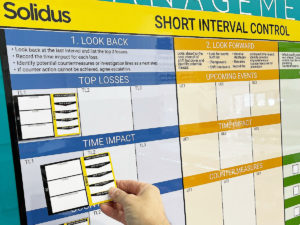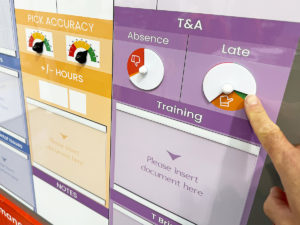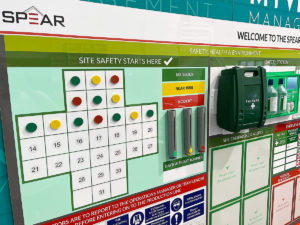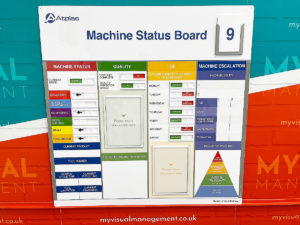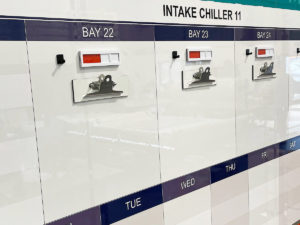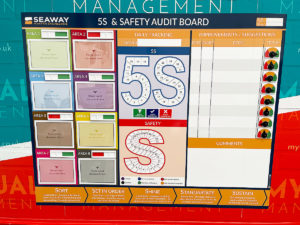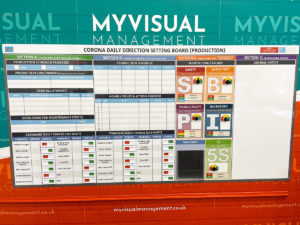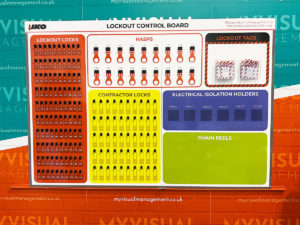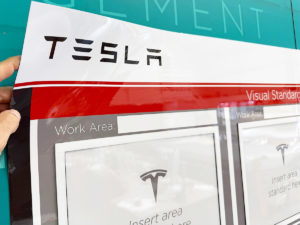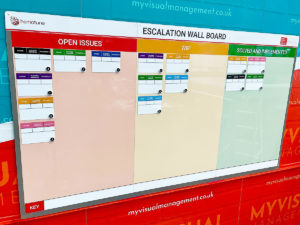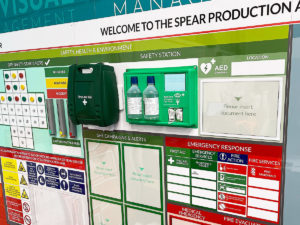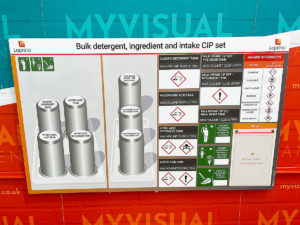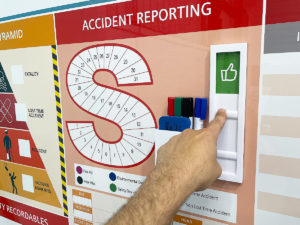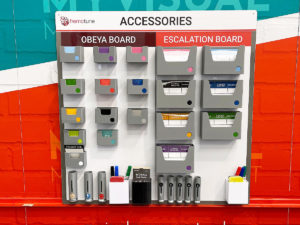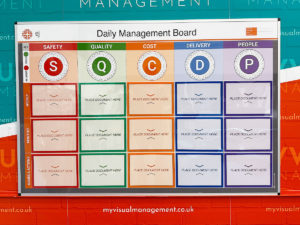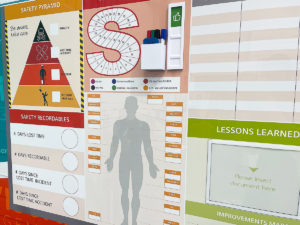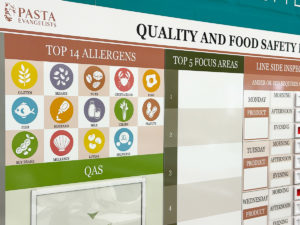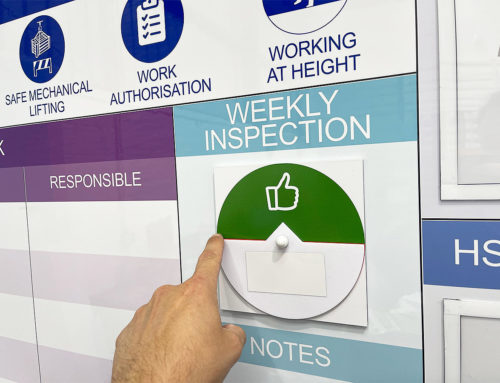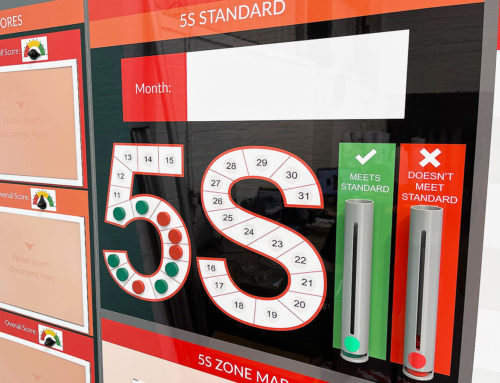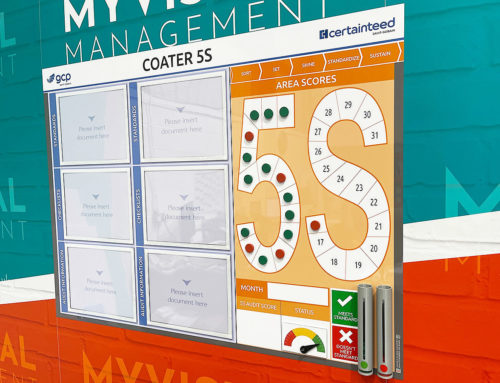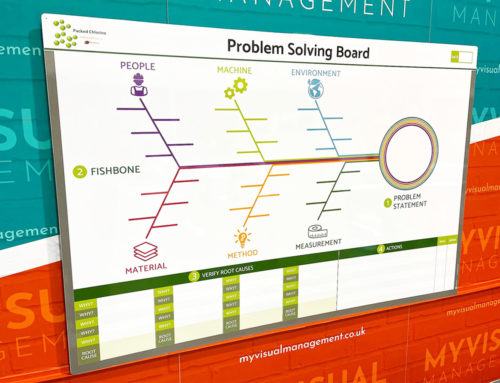By My Visual Management — Making Continuous Improvement Visual
Visual Management in Lean and Continuous Improvement is about turning performance, standards, and problems into something everyone can see — and therefore act on. In this guide, we explore what Visual Management means in a Lean context, why it drives Continuous Improvement, and how to apply it to create engaged, high-performing teams.
1) What Is Visual Management in Lean and Continuous Improvement?
Visual Management is a system that uses visual cues — such as boards, signs, colour codes, and symbols — to communicate information quickly and clearly. It helps teams see at a glance what’s working, what isn’t, and what needs attention.
In Lean and Continuous Improvement, this approach builds transparency, reduces waste, and supports sustainable performance. When information is visible, teams spend less time searching, asking, or guessing — and more time improving.
2) The Principles of Visual Control in Lean
a) Visibility
Every visual should tell a story in seconds. Clear, simple design — readable from a distance — is essential.
b) Standardisation
Consistent colours, icons, and layouts mean any team member can understand any board instantly.
c) Immediacy of Feedback
Visuals show status in real time. Red means act; green means proceed. Feedback loops tighten, and issues are caught early.
d) Accessibility
Information should live where the work happens — at the point of use — not hidden in spreadsheets or systems.
e) Engagement
The best visuals invite action. When teams own their boards, they own their results.
3) Why Visual Management in Lean and Continuous Improvement Drives Results
Visual Management in Lean and Continuous Improvement turns abstract goals into tangible habits. It:
- Makes performance visible – so teams can see progress and gaps.
- Encourages accountability – clear ownership of actions and metrics.
- Reduces communication barriers – everyone shares one version of the truth.
- Triggers problem-solving – issues are seen early and addressed fast.
In Lean environments, this visibility is the foundation of Continuous Improvement — empowering everyone to identify waste and take action.
4) Types of Visual Management Boards
5S Boards
Used to support workplace organisation and cleanliness. They show what “good” looks like, track audits, and display before/after improvements. See further 5S examples.
KPI Boards
These boards show key performance metrics — safety, quality, delivery, cost, people (SQDCP) — often reviewed in daily huddles. Review further KPI examples.
Continuous Improvement (CI) Boards
A space to capture ideas, assign actions, and track results. They make the Plan–Do–Check–Act (PDCA) or A3 problem-solving process visible. Find further Continuous Improvement examples.
Safety & Cleaning Stations
Visual layouts ensure tools and cleaning equipment are always in the right place. They reinforce safety habits and reduce time wasted searching. Visit a gallery of cleaning station examples.
Status Indicators & Board Accessories
Status Indicators make board data dynamic — colour-coded signals instantly show progress, risks, or completed actions. At My Visual Management, we offer a complete range of visual accessories that bring boards to life. These tools help teams update information instantly, maintain visibility, and keep boards engaging and up to date.
5) How to Implement Visual Management in Lean and Continuous Improvement Successfully
Step 1: Define the Purpose
What decision or behaviour should this board support? Keep it focused.
Step 2: Involve the Team
Co-design the layout with the people who’ll use it daily. Ownership drives engagement.
Step 3: Start Small and Iterate
Pilot one area. Observe for a week. Improve based on feedback before rolling out widely.
Step 4: Use Consistent Visual Grammar
Agree on standard colours, symbols, and formats. Consistency builds recognition.
Step 5: Maintain the Cadence
Boards only work if they’re used daily. Schedule short huddles, keep updates quick, and remove anything unused.
6) Tips for Success with Visual Management in Lean and Continuous Improvement
- Keep designs simple and purposeful — being clear wins.
- Treat boards as decision tools, not decoration.
- Assign clear ownership for updates and reviews.
- Encourage team input when refining board layouts.
- Keep boards current — fresh visuals keep engagement high.
- Use Status Indicators and board accessories to make data visible and interactive.
7) Real-World Examples and Applications
Manufacturing
Production teams use KPI and 5S boards to track output, safety incidents, and machine status. Visual cues help maintain flow and highlight issues fast.
Healthcare
Hospitals use visual huddle boards to align shifts, track quality, and communicate patient safety goals — improving reliability and teamwork.
Logistics & Service Environments
From call centres to warehouses, visual boards make workloads and service levels visible, enabling teams to respond before issues escalate.
8) Measuring the Impact of Visual Management in Lean and Continuous Improvement
You’ll know it’s working when:
- Teams discuss boards daily.
- Problems are raised and resolved visibly.
- Metrics trend toward targets.
- The workplace feels calmer and more in control.
Quantitative signs include faster response times, fewer errors, higher audit scores, and improved morale.
9) The Future of Visual Management Boards
As workplaces evolve, boards remain the physical anchor for alignment. Trends include:
- Modular layouts that adapt as processes change.
- Integration of Status Indicators, quick-change graphics, and colour-coded accessories.
- A growing focus on design quality — clarity, colour hierarchy, and usability.
The best boards don’t just show data; they shape behaviour.
How We Can Help
At My Visual Management, we design, produce, and ship Visual Management systems that make improvement visible — from 5S and KPI boards to Cleaning Stations, CI boards, and Status Indicators. We can incorporate your data, colour standards, and layouts, and prototype fast for team testing.
Making Continuous Improvement Visual.
Encourage interactive visual management boards
Be clear, at a glance
Use red and green status for clear visual status
start on one line, machine or cell before rolling out your visual management
Make your own process visual
Make your visual management board your single source of truth
Create a real-time visual dashboard
Rely on coherent visual management where all you need is in one place
Provide a dedicated area where teams and colleagues can successfully perform
Benefit from flexible and engaging visual tools
Bring visual, functional and intuitive together
Blend familiar icons with well framed visuals for intuitive results
Making status visual and interactive is key
Colour coding is instantly comprehensible
Change documentation quickly and easily
Take concern about safety to the next level
Visuals working for your setting
Further examples
Our Approach
We create visual management boards everyday. As a result we have plenty of experience. We work for organisations in food production, the power industry, national rail, pharmaceuticals, education, healthcare, packaging and distribution.
Our team works with a simple idea or sketch and creates a professionally designed layout. This is then turned into a highly functional visual management board.
We offer customised options because we want to create the perfect board for you. So, here are a few examples. We can add magnetic areas or a dry-wipe finish (for use with whiteboard pens). Furthermore, you can choose Red/Green sliders or R.A.G. (Red, Amber, Green) status dials so you can quickly and visually update your board. These are just a few examples of the ways in which our boards can be tailored to meet your needs. You may also be interested in whiteboard overlays that can be used on top of an existing magnetic board.


